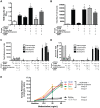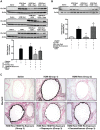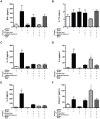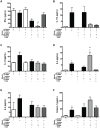Differential effects of rapamycin and dexamethasone in mouse models of established allergic asthma
- PMID: 23349887
- PMCID: PMC3547928
- DOI: 10.1371/journal.pone.0054426
Differential effects of rapamycin and dexamethasone in mouse models of established allergic asthma
Abstract
The mammalian target of rapamycin (mTOR) plays an important role in cell growth/differentiation, integrating environmental cues, and regulating immune responses. Our lab previously demonstrated that inhibition of mTOR with rapamycin prevented house dust mite (HDM)-induced allergic asthma in mice. Here, we utilized two treatment protocols to investigate whether rapamycin, compared to the steroid, dexamethasone, could inhibit allergic responses during the later stages of the disease process, namely allergen re-exposure and/or during progression of chronic allergic disease. In protocol 1, BALB/c mice were sensitized to HDM (three i.p. injections) and administered two intranasal HDM exposures. After 6 weeks of rest/recovery, mice were re-exposed to HDM while being treated with rapamycin or dexamethasone. In protocol 2, mice were exposed to HDM for 3 or 6 weeks and treated with rapamycin or dexamethasone during weeks 4-6. Characteristic features of allergic asthma, including IgE, goblet cells, airway hyperreactivity (AHR), inflammatory cells, cytokines/chemokines, and T cell responses were assessed. In protocol 1, both rapamycin and dexamethasone suppressed goblet cells and total CD4(+) T cells including activated, effector, and regulatory T cells in the lung tissue, with no effect on AHR or total inflammatory cell numbers in the bronchoalveolar lavage fluid. Rapamycin also suppressed IgE, although IL-4 and eotaxin 1 levels were augmented. In protocol 2, both drugs suppressed total CD4(+) T cells, including activated, effector, and regulatory T cells and IgE levels. IL-4, eotaxin, and inflammatory cell numbers were increased after rapamycin and no effect on AHR was observed. Dexamethasone suppressed inflammatory cell numbers, especially eosinophils, but had limited effects on AHR. We conclude that while mTOR signaling is critical during the early phases of allergic asthma, its role is much more limited once disease is established.
Conflict of interest statement
Figures








References
-
- Bateman ED, Hurd SS, Barnes PJ, Bousquet J, Drazen JM, et al. (2008) Global strategy for asthma management and prevention: GINA executive summary. The Eur Respir J 31: 143–178. - PubMed
-
- Hamid Q, Tulic M (2009) Immunobiology of asthma. Annu Rev Physiol 71: 489–507. - PubMed
-
- Holgate ST (2012) Innate and adaptive immune responses in asthma. Nat Med 18: 673–683. - PubMed
-
- Hesselmar B, Aberg B, Eriksson B, Aberg N (2000) Asthma in children: prevalence, treatment, and sensitization. Pediatr Allergy Immunol 11: 74–79. - PubMed
Publication types
MeSH terms
Substances
Grants and funding
LinkOut - more resources
Full Text Sources
Other Literature Sources
Medical
Research Materials
Miscellaneous

